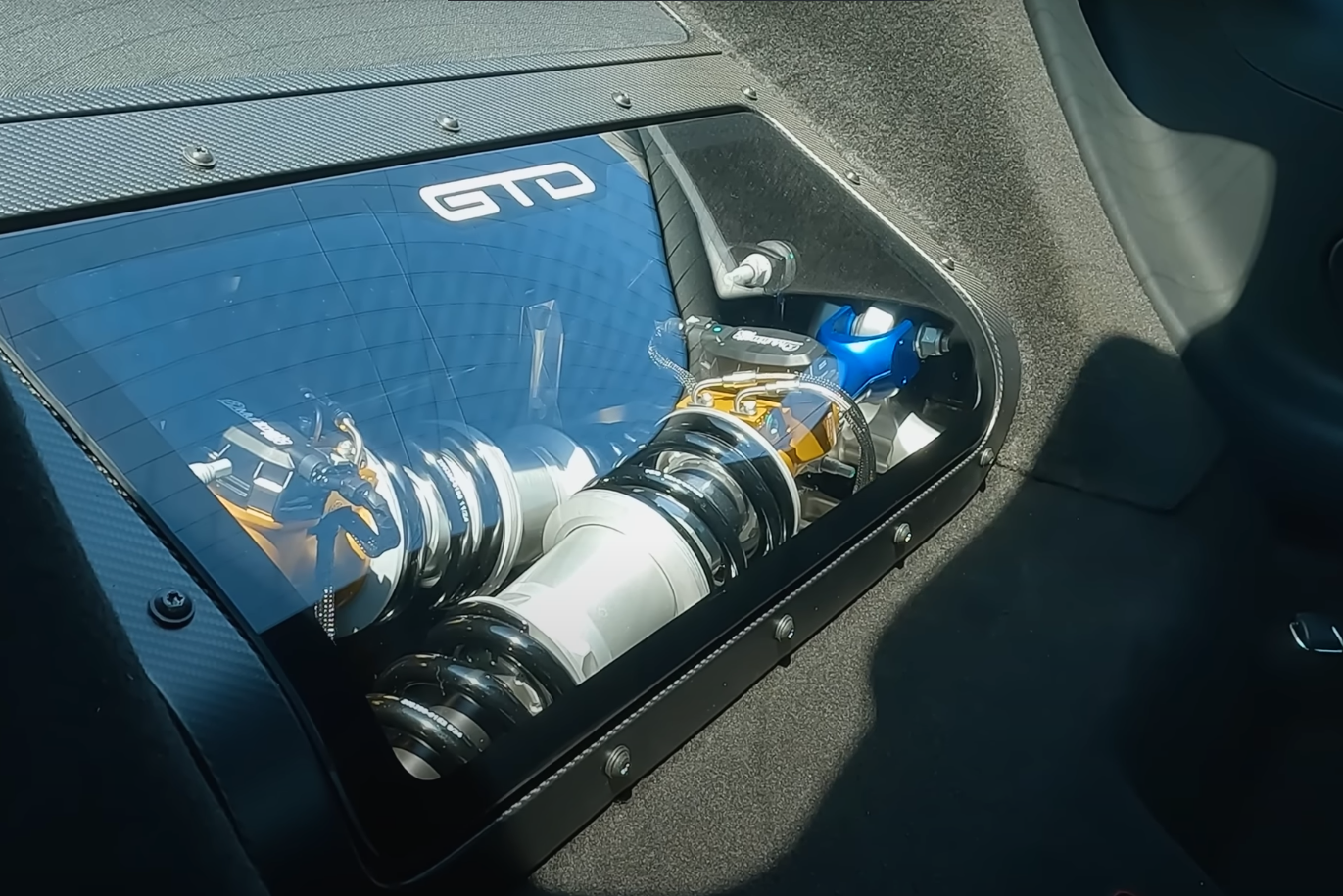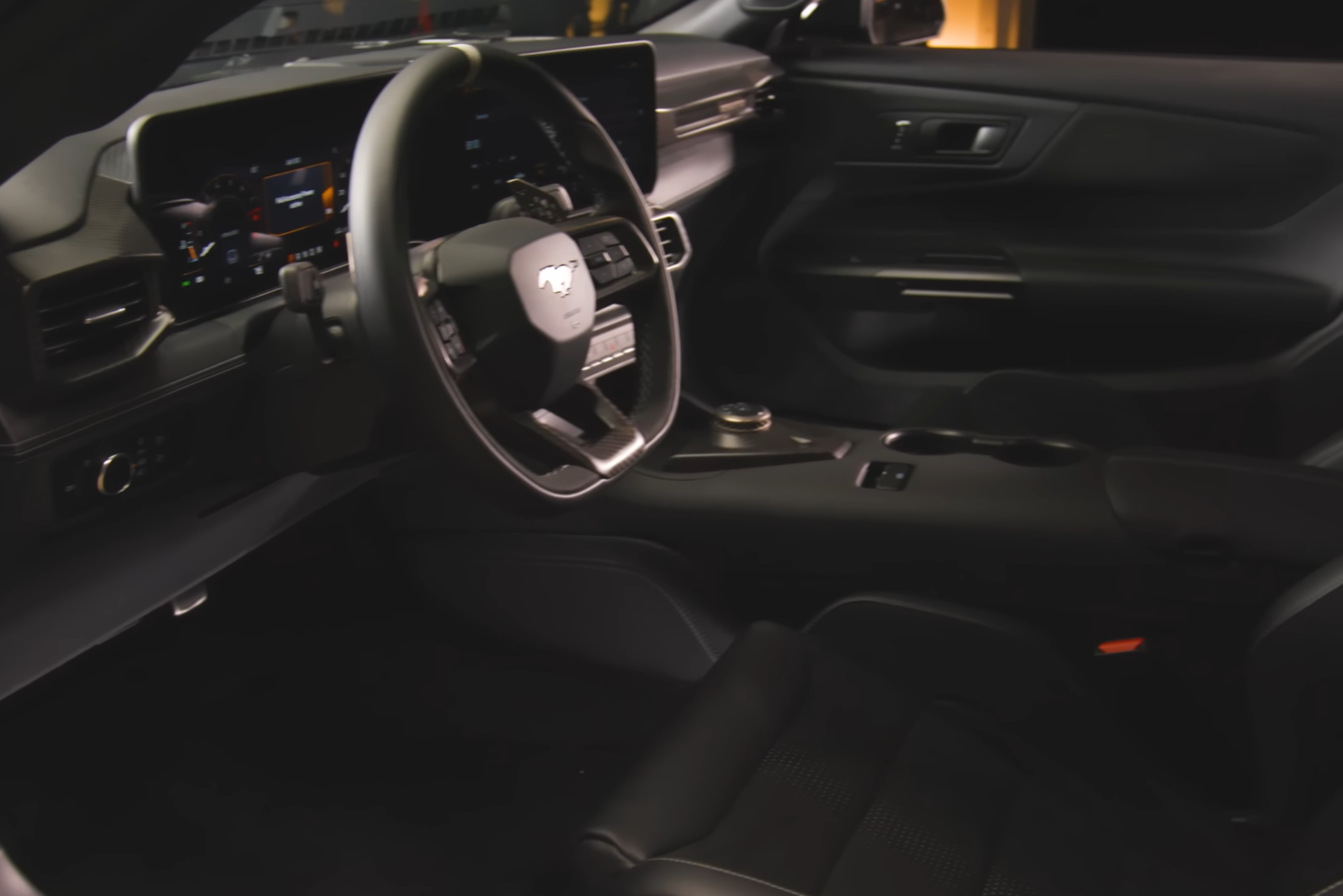For many car fans, the wait for the 2025 Mustang GTD has been long but worth it. This new model brings a mix of instant power, advanced technology, and daring design choices that set it apart from most sports cars. From a chassis that delivers a sharp driving experience to aerodynamic features inspired by racing, the GTD marks a new step for the Mustang name.
The 2025 Mustang GTD is not just fast; it was built to achieve records and compete with some of the top cars from Europe. Its engineering, including systems usually seen in race cars, shows Ford’s focus on performance and innovation. This model also highlights Ford’s growing confidence as it takes on other leading brands and brings new excitement to its lineup.
Key Takeaways
- The 2025 Mustang GTD combines fast response with engineering from racing.
- Its design and technology are focused on top-level performance.
- This model challenges rivals and highlights Ford’s commitment to innovation.
2025 Mustang GTD Summary
Legacy and Importance
The 2025 Mustang GTD stands out as a major chapter in the Mustang’s history. It brings together high performance and advanced technology in a way that honors Mustang’s past achievements. This model also connects to motorsport moments like Le Mans, highlighting the progress made since early Mustang models first appeared in showrooms.
Ford’s decision to develop the GTD shows confidence in creating an American sports car that can take on respected European rivals. It is not just another performance car—it carries the weight of Mustang’s long history.
Differences From Earlier Mustang Versions
The Mustang GTD is unlike previous Mustang models. Key changes include:
- A focus on high-speed handling, with engineering details such as a rear transaxle and a carbon fiber drive shaft for better weight balance.
- The Performance Pack includes features like a Drag Reduction System (DRS) and enhanced aerodynamics that are not seen on regular Mustangs.
- This version uses racing-inspired components like the dry sump system and advanced suspension, aiming for results such as a sub-seven-minute Nürburgring lap.
- The GTD is the first American front-engine car to achieve that ring time.
A simple comparison table:
| Feature | 2025 Mustang GTD | Previous Mustang Models |
|---|---|---|
| Aerodynamics | Advanced DRS, extra vents | Basic or moderate aero |
| Chassis Tech | Modern, rigid, track-tuned | Standard muscle car focus |
| Performance Pack | Available, high impact | Not available or limited |
| Rear Transaxle | Yes | No |
| Price | Starts over $300,000 | Much lower |
Small-Batch Manufacturing Story
Production of the 2025 Mustang GTD is very limited. Ford is making only a small number, which helps make each car feel unique and desirable. This level of rarity is unusual for a Mustang, as most past models were built in higher volumes.
The limited run is part of what makes the GTD so special. Buyers are getting features and tech that are not standard, not even on the racecar version. Ford’s choice to produce so few GTDs helps build excitement and ensures that each one stands out from the rest of the Mustang lineup.
Standout Performance and Engineering Features
Powerplant and Drivetrain
The 2025 Mustang GTD comes equipped with an engine that delivers immediate torque, offering a level of responsiveness that stands out compared to many supercars. The car’s powertrain is designed for both high speed and reliability, supported by innovations such as a dry sump system. This setup helps maintain oil flow even under aggressive driving, enhancing both performance and durability.
Key Powertrain Highlights:
- Instant torque response
- Purpose-built dry sump system
- Engineered for track and road use
State-of-the-Art Frame and Handling
Ford has integrated advanced chassis technology and updated suspension systems into the GTD. The chassis is carefully tuned to handle high levels of downforce and cornering forces. Aerodynamic elements, including a drag reduction system (DRS) and carefully designed canards, help maximize grip at speed. The DRS system, inspired by Formula 1, adjusts for efficient airflow at high speeds to keep the car stable and planted.
Performance Features Table:
| Feature | Benefit |
|---|---|
| DRS system | Increases straight-line speed |
| Front canards | Adds front-end downforce |
| Stiff frame-mount | Improves rigidity and control |
Rear-Mounted Transmission and Balanced Mass
A rear-positioned transaxle was chosen to optimize front-to-rear weight balance. By placing the transmission at the back, weight is spread more evenly throughout the car, which improves traction and overall handling. Additional details like a carbon fiber drive shaft were also included for performance gains, even though they were not strictly necessary.
- Rear transaxle for optimal weight distribution
- Carbon fiber drive shaft for reduced mass
- Focus on balanced handling for track and street
Carbon Construction and Lightweight Solutions
Ford made heavy use of carbon fiber and other advanced materials throughout the Mustang GTD. Notable features include direct attachment points for key aerodynamic components, such as the rear wing supports being built through the C-pillar. This approach improves both rigidity and aerodynamic performance.
Innovative Material Use:
- Carbon fiber for major structural and aerodynamic parts
- Direct integration of downforce elements for stability
- Focus on durability alongside reduced weight
All design decisions serve a clear goal: to deliver race-level performance in a road-ready package.
Aerodynamics and Technology
Advanced Performance Package Details
The advanced model comes equipped with a unique set of features, adding aerodynamic parts at the front, including canards and other unseen elements that make a real difference in driving. These upgrades were designed to help the car achieve a Nürburgring lap time under seven minutes, a feat only four cars have ever accomplished. The addition of improved dampers and specific aerodynamic parts sets this version apart for drivers seeking top results.
Performance Highlights:
- Purpose-built aerodynamic pieces
- Special front-end enhancements
- Upgraded dampers for enhanced control
- Targeted to break performance records
Adjustable Drag System
An adjustable drag system, similar to technology seen in Formula 1 cars, is part of the package. This feature, called a drag reduction system, lets parts of the rear spoiler become flat at high speeds to reduce air resistance. Unlike the race-only versions, the road car includes this technology, offering drivers something not found in models designed just for the track.
How the system works:
| State | Benefit |
|---|---|
| Flat position | Lower drag, faster top speed |
| Raised position | More grip, extra cornering stability |
Downforce and Cornering Ability
The design produces up to nearly 2,000 pounds of force pushing the car to the ground when reaching speeds of 180 miles per hour. This extra pressure gives much better grip on the road, especially at higher speeds. The structure that supports the rear wing is attached through the pillar area, not just the trunk, making it very strong and able to handle the extra force during tight turns.
Key Points:
- About 2,000 lbs downforce at 180 mph
- Rear wing mounted for strength and stability
- Improved handling at extreme speeds
Unique Features for Road Use
This car includes several features that are only available on the street model and not on the race versions. These include special vents by the wheels for better airflow and an advanced rear suspension with a rear transaxle and a carbon fiber driveshaft to help balance weight across the car. The result is a model with advanced technology not often seen outside the racetrack.
Notable Street-Only Technologies:
- Wheel vents for improved air extraction
- Rear transaxle for better weight distribution
- Carbon fiber driveshaft for extra strength
- Larger selection of aerodynamic options compared to the race car
Track Heritage and Accomplishments
Victories at Iconic Tracks
The Mustang GTD stands out due to its performance at top racing venues. With the performance package, it broke the seven-minute mark at the Nürburgring, becoming the first American car to achieve this. Only four cars have ever done it, which puts it in rare company.
A table below lists key highlights:
| Achievement | Details |
|---|---|
| Nürburgring Lap Time | Under 7 minutes |
| Le Mans Participation | Proven endurance and speed |
| Engine Layout | Unique as a front-engine winner |
Race-Driven Engineering
Many technologies found in the Mustang GTD come directly from motorsports. The car features an advanced DRS (drag reduction system), providing nearly 2,000 pounds of downforce at 180 mph. Strong chassis parts, a rear transaxle, and a carbon fiber driveshaft also come straight from racing.
List of motorsport-derived features:
- DRS for increased speed and control
- Rear transaxle for better balance
- Carbon fiber driveshaft
- Dampers and suspension tuned for high-speed tracks
Some features in the road car, such as specific aero improvements, are not even present on the racing version, showing the brand’s focus on innovation.
Strengthening Brand Reputation
Success on the track directly influences the brand’s image. The Mustang GTD’s performance at events like Le Mans and the Nürburgring boosts trust in its ability and technology. Featuring high-level engineering in a Mustang at this price point may seem bold for an American brand, but these achievements prove that it can compete with rivals like Porsche. Track results have helped restore the old racing slogan: “race on Sunday, sell on Monday,” giving customers clear proof of the model’s ability and building lasting credibility.
How the GTD Shapes the Industry and Stands Out
Taking on Porsche and Top-Level Competitors
The Mustang GTD enters the supercar scene with features designed to rival established European brands. Its performance pack includes advanced aerodynamic elements, such as active drag reduction systems and additional downforce capabilities. These features are not common in most road cars and are usually reserved for high-end race cars.
Ford chose to engineer details like a rear transaxle and carbon fiber drive shaft for the GTD. These enhancements show clear intent to match or surpass the handling and speed of cars like the Porsche GT2 RS and GT3 RS. The Mustang GTD’s Nürburgring lap time, coming in under seven minutes, positions it against a small group of elite vehicles.
Comparison Table: Notable Features
| Feature | Mustang GTD | Common Supercars |
|---|---|---|
| Drag Reduction Sys. | Yes | Rare |
| Rear Transaxle | Yes | Sometimes |
| Carbon Driveshaft | Yes | Sometimes |
| Nürburgring < 7 min | Yes | Few Achieve This |
Perceptions in the Market and the Car’s Unique Offer
The GTD stands out with its aggressive price point, starting above $300,000. This high cost puts it in the same range as some luxury supercars, but Ford has chosen to keep the Mustang name instead of creating a new luxury sub-brand.
This approach highlights confidence in the Mustang’s legacy and its ability to justify the cost through performance and exclusivity. The use of advanced parts, track-focused technologies, and proven results in racing strengthen its value proposition. The car’s authenticity and visible connection to motorsports add credibility for both collectors and performance enthusiasts.
Key points:
- Maintains the Mustang badge despite the supercar status
- Focuses on real racing results to support its reputation
- Offers race-level features to regular buyers
Impact on American High-Performance Cars
The GTD represents a bold step for American engineering in the sports car market. Its achievements, such as the sub-seven-minute lap and being the first American front-engine car to do so, set new standards for domestic manufacturers.
Ford’s decision to put high-tech features and costly engineering into the Mustang platform signals a return to “race on Sunday, sell on Monday.” This connects car enthusiasts to the brand’s racing heritage and showcases that American manufacturers can compete at the top on a global stage.
Summary List: American Car Highlights
- First front-engine U.S. car to lap Nürburgring under seven minutes
- Brings advanced racing technologies to a mass-market model
- Encourages a new era of ambitious, high-cost American sports cars
The GTD shows how tradition can blend with modern technology, influencing competitors and raising expectations for future American performance vehicles.
Approach to Design and Engineering
Purpose and Inspiration for the Mustang GTD
The Mustang GTD was created to combine fast, direct response and cutting-edge chassis technology. The team wanted to take on the best cars in the world and prove American engineering could compete. Every detail was chosen to make the car quick, strong, and unique among sports coupes. The Mustang GTD stands out for having features even top race cars do not include.
Teamwork and Important Contributors
A group of dedicated car experts played a big role in the Mustang GTD project, including high-level leaders. There were strong opinions and even debates about important choices, like how the rear wing was attached for extra downforce. Engineers and leaders worked together, sometimes arguing, but always focused on what was best for handling and performance. This teamwork led to bold choices that shaped the final car.
| Key Team Actions | Impact |
|---|---|
| Open discussions on technical ideas | Better solutions for problems |
| Direct involvement from leadership | Focus on quality and innovation |
| Strong push for performance features | Unique, track-capable road car features |
Focus on Precision and Creative Solutions
The Mustang GTD uses advanced features that improve speed and grip, like the DRS drag system and strong rear wing supports. The car also has special air vents for better airflow and a rear transaxle for improved balance. Even choices that cost more or required extra work were made because they added real value. These solutions came from paying attention to every small part and being ready to try new ideas, making the car a leader in performance and design.
Owner Pride and Brand Image
Rarity and Appeal to Enthusiasts
The Mustang GTD stands out as a special model, bringing with it a strong sense of pride and ownership for those lucky enough to get one. It is a unique car, made even more appealing by its limited availability and the attention to detail in each unit. Owners appreciate features that set it apart from both regular and racing models, like the air extraction vents and the rear stanchion that is built for maximum downforce.
- Limited production: Each car carries its own number, making every unit feel exclusive.
- Special features: Road cars receive advanced technology not found in the racing versions.
- Personal connection: Some owners have a history of owning similar rare Fords, providing a strong sense of legacy.
| Feature | Unique to GTD Owner Experience |
|---|---|
| Numbered car editions | Yes |
| Race-level aerodynamics | Yes |
| Availability | Very limited |
| Brand legacy connection | Strong |
Ford’s Role in Performance Cars
Ford takes pride in building high-performance vehicles without hiding behind sub-brands. While other companies might use different names for their top models, Ford puts its name front and center, even with cars priced at the top of the market. This direct approach creates trust and clear identity.
- Ford positions itself boldly in the high-performance sports car segment.
- Mustang GTD competes directly with top European models like the Porsche GT2 RS and GT3 RS.
- Race results and on-road success add to Ford’s reputation for performance and innovation.
Notable brand points:
- Ford remains “unapologetic” in entering the high-end market.
- The Mustang is now the world’s best-selling sports coupe, highlighting the success of this strategy.
- Track success improves the brand’s image and proves the car’s real-world capabilities.








